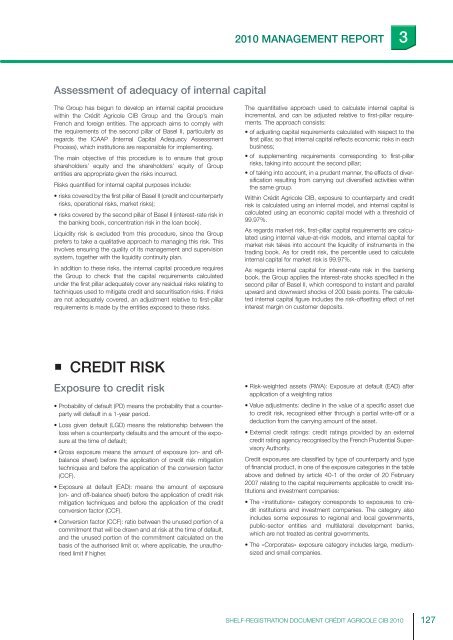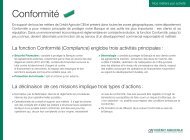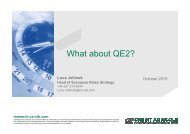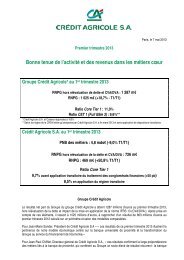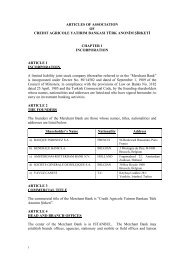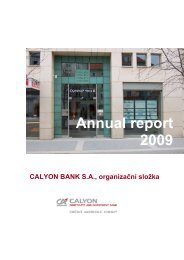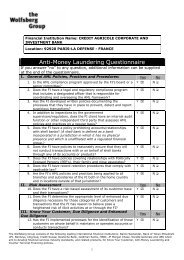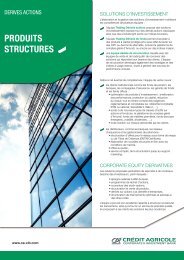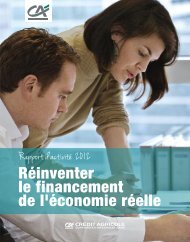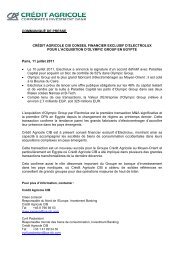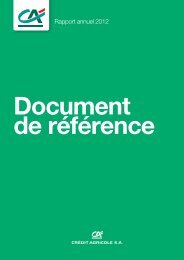ourexpertise - Crédit Agricole CIB
ourexpertise - Crédit Agricole CIB
ourexpertise - Crédit Agricole CIB
Create successful ePaper yourself
Turn your PDF publications into a flip-book with our unique Google optimized e-Paper software.
2010 MANAGEMENT REPORT 3Assessment of adequacy of internal capitalThe Group has begun to develop an internal capital procedurewithin the <strong>Crédit</strong> <strong>Agricole</strong> <strong>CIB</strong> Group and the Group’s mainFrench and foreign entities. The approach aims to comply withthe requirements of the second pillar of Basel II, particularly asregards the ICAAP (Internal Capital Adequacy AssessmentProcess), which institutions are responsible for implementing.The main objective of this procedure is to ensure that groupshareholders’ equity and the shareholders’ equity of Groupentities are appropriate given the risks incurred.Risks quantifi ed for internal capital purposes include:• risks covered by the fi rst pillar of Basel II (credit and counterpartyrisks, operational risks, market risks);• risks covered by the second pillar of Basel II (interest-rate risk inthe banking book, concentration risk in the loan book).Liquidity risk is excluded from this procedure, since the Groupprefers to take a qualitative approach to managing this risk. Thisinvolves ensuring the quality of its management and supervisionsystem, together with the liquidity continuity plan.In addition to these risks, the internal capital procedure requiresthe Group to check that the capital requirements calculatedunder the fi rst pillar adequately cover any residual risks relating totechniques used to mitigate credit and securitisation risks. If risksare not adequately covered, an adjustment relative to fi rst-pillarrequirements is made by the entities exposed to these risks.The quantitative approach used to calculate internal capital isincremental, and can be adjusted relative to fi rst-pillar requirements.The approach consists:• of adjusting capital requirements calculated with respect to thefi rst pillar, so that internal capital refl ects economic risks in eachbusiness;• of supplementing requirements corresponding to fi rst-pillarrisks, taking into account the second pillar;• of taking into account, in a prudent manner, the effects of diversification resulting from carrying out diversifi ed activities withinthe same group.Within <strong>Crédit</strong> <strong>Agricole</strong> <strong>CIB</strong>, exposure to counterparty and creditrisk is calculated using an internal model, and internal capital iscalculated using an economic capital model with a threshold of99.97%.As regards market risk, fi rst-pillar capital requirements are calculatedusing internal value-at-risk models, and internal capital formarket risk takes into account the liquidity of instruments in thetrading book. As for credit risk, the percentile used to calculateinternal capital for market risk is 99.97%.As regards internal capital for interest-rate risk in the bankingbook, the Group applies the interest-rate shocks specifi ed in thesecond pillar of Basel II, which correspond to instant and parallelupward and downward shocks of 200 basis points. The calculatedinternal capital fi gure includes the risk-offsetting effect of netinterest margin on customer deposits.• CREDIT RISKExposure to credit risk• Probability of default (PD) means the probability that a counterpartywill default in a 1-year period.• Loss given default (LGD) means the relationship between theloss when a counterparty defaults and the amount of the exposureat the time of default;• Gross exposure means the amount of exposure (on- and offbalancesheet) before the application of credit risk mitigationtechniques and before the application of the conversion factor(CCF).• Exposure at default (EAD): means the amount of exposure(on- and off-balance sheet) before the application of credit riskmitigation techniques and before the application of the creditconversion factor (CCF).• Conversion factor (CCF): ratio between the unused portion of acommitment that will be drawn and at risk at the time of default,and the unused portion of the commitment calculated on thebasis of the authorised limit or, where applicable, the unauthorisedlimit if higher.• Risk-weighted assets (RWA): Exposure at default (EAD) afterapplication of a weighting ratios• Value adjustments: decline in the value of a specifi c asset dueto credit risk, recognised either through a partial write-off or adeduction from the carrying amount of the asset.• External credit ratings: credit ratings provided by an externalcredit rating agency recognised by the French Prudential SupervisoryAuthority.Credit exposures are classifi ed by type of counterparty and typeof fi nancial product, in one of the exposure categories in the tableabove and defi ned by article 40-1 of the order of 20 February2007 relating to the capital requirements applicable to credit institutionsand investment companies:• The « institutions« category corresponds to exposures to creditinstitutions and investment companies. The category alsoincludes some exposures to regional and local governments,public-sector entities and multilateral development banks,which are not treated as central governments.• The « Corporates« exposure category includes large, mediumsizedand small companies.SHELF-REGISTRATION DOCUMENT CRÉDIT AGRICOLE <strong>CIB</strong> 2010 127


